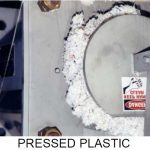Pressing News
August 3, 2015
An interesting niche exists in the secondary fiber market. It involves firms which recycle cut-out scrap from producers of water resistant paper containers.
There are many firms which produce pails for KFC® chicken, paper cups for Coca Cola®, gable top containers for Tropicana® orange juice, boxes for Ben & Jerry’s® ice cream, and similar containers. These items are made of high quality bleached paper which is coated on both sides with printable polyethylene. The products are made from shapes which are die cut from large rolls of paper. This paper is produced by well known firms such as International Paper and Georgia-Pacific.
The trim resulting from the production of the required cut-outs can be recycled to recover the long fiber pulp found between the layers of polyethylene. The pulp is sold as market pulp. Because of the high quality of the fiber, the pulp is blended with other fibers to improve the overall strength of specialty papers.
The recycling begins with loading the trim into a hydrapulper. Water is blended with the trim and a thick slurry is produced. The pulper can have a screened bottom which holds back the plastic film, but which allows the fiber slurry to pass through.
As the trim is pulped, the fiber is rubbed free of the plastic film. A dilute flow of this fiber is drained from the pulper. At one mill is it prethickened with a sidehill screen and then dewatered with a Vincent screw press. The press cake is filled into bulk bags for shipment to the end users.
Typically the pulp is run through a dryer to produce thick sheets of market pulp.
Another application for a Vincent screw press, at these same facilities, is to dewater the rejected polyethylene film. This plastic is sold to plastic recyclers who process it into plastic pellets or proprietary plastic products.






